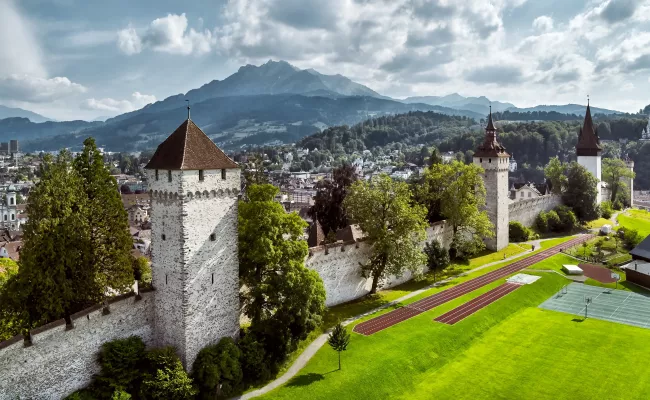The Musegg Wall in Lucerne is a well-preserved medieval fortification dating from the fourteenth century. Notably, it is one of the city’s medieval fortifications, composed of nine towers connected by a protective wall surrounding the ancient town. Furthermore, the wall served both defensive and administrative purposes, preventing access to the city and sheltering municipal officials.
History
The Musegg Wall in Lucerne, Switzerland, plays an important role in the city’s history and skyline. Built-in the late 14th century, this well-preserved stronghold originally had nine towers, four of which still survive today: the Zyt, Schirmer, Nölli, and Mannli towers.
Historical Significance
During the medieval period, the wall was a protective fortification that protected the city from external assaults. The Zyt tower, which dates back to roughly 1442, houses the famed Zyt Tower Clock, one of Switzerland’s oldest working clocks.
Renovations and Adaptations
The Musegg Wall has undergone renovations and modifications over the years to adapt to evolving defense techniques and architectural styles. Today, it is a treasured historical site and a testimony to Lucerne’s rich medieval legacy, with panoramic views of the city and Lake Lucerne from its walls.
Revealing Lucerne’s Enduring Splendor
Lucerne’s Heritage Trails encourage tourists to discover the city’s medieval history. The paths provide a timeless journey through stunning architecture, historical stories, and the enchanting beauty of Lucerne’s streets.
Embarking on a Heritage Journey
Embark on a heritage journey around Lucerne, where each turn unveils a new chapter in the city’s intriguing history. Discover the medieval mysteries and immerse yourself in the eternal beauty that marks Lucerne’s legacy.
Biodiverse sanctuary
Not only does the Musegg Wall look fascinating from a distance, but it also serves as a valuable habitat for some plants and animals, including endangered species. Furthermore, the Musegg Wall supports uncommon breeding bird species, such as jackdaws, goosanders, alpine swiftlets, and common swiftlets. The wall also supports a diverse range of fauna, including bats, common wall lizards, wild and honey bees, spiders, slugs, and snails, as well as specialist plants.
